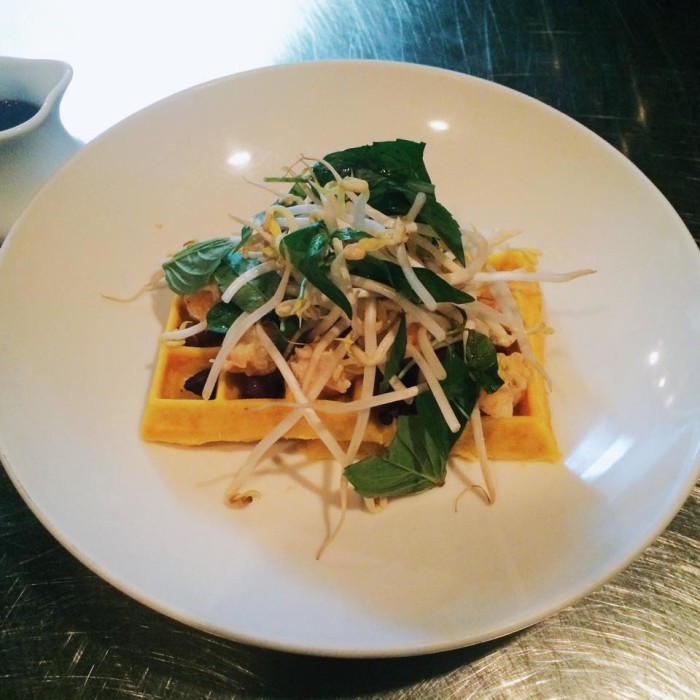What Is Fish Sauce Caramel?
Fish sauce, the savory brown liquid that's ubiquitous in Southeast Asian cuisines, is often described with words like "funky," "fishy" and "umami." What happens when you add it to some melting sugar? You get something called fish sauce caramel — naam plaa waan in Thai or nuoc mau in Vietnamese — and it can be drizzled over almost anything, according to three New York chefs.
Ann Redding, chef-owner of Uncle Boons in New York's Nolita, grew up in Thailand, where she was introduced to fish sauce caramel as a dipping sauce for green mango. She now serves the sweet fish sauce, as it literally translates to in Thai, with raw radishes and as a complement to the restaurant's marinated pork riblets in shrimp paste. Redding makes the dip by reducing fish sauce with palm sugar, chilies, shrimp paste and dried shrimp.
"We had recently removed a pork and shrimp paste fried rice dish from our menu (a traditional dish and one of my favorites)," Redding says. "[The pork riblets] was my way of keeping those flavors on the menu. We felt it needed something slightly sweet to balance the flavors and added the fish sauce caramel to accomplish that."
At Nightingale 9, a Vietnamese and Southern-infused joint in Brooklyn's Carroll Gardens, executive sous chef Morgan Jarrett breaks away from traditional Vietnamese cuisine in two ways: a banh xeo Waffle and black fish sauce caramel. Jarrett transforms banh xeo, a popular street snack from Vietnam that resembles a crepe made with rice flour, turmeric and coconut milk, into a fluffy waffle by adding baking powder and eggs. Jarrett's version of the condiment adds black vinegar to the mix, hence black fish sauce caramel. The thin, fishy sauce, indeed reminiscent of maple syrup, is better represented by the phrase "sweetened fish sauce" than "savory caramel."
"I'm kind of stretching the boundaries of what you should be doing with banh xeo by putting [the black fish sauce caramel] on top but I wanted to draw a bridge and it worked," Jarrett says.
Jarrett describes the taste of the fishy caramel as: "Somewhere between the texture of maple syrup, like the sweetness level of sorghum, but with umami. You just have this light taste of fish sauce-slash-anchovy if you will."
How did Jarrett come to the idea of turning a rice flour crepe into a waffle? It may or may not have been influenced by substances of some nature.
"I wasn't high, but it was one of those moments where I woke up and was like, 'Why don't I put that in the waffle iron?!'" she jokes. "It started off as a brunch item and then just got onto the all day, all night menu. That was kind of [another] catalyst of the invention — doing some kind of funky Vietnamese brunch."
Some more traditional Vietnamese applications of the sauce, according to Jarrett, is drizzled over whole grilled or fried fish or pork belly. Before the banh xeo waffle came along, Nightingale 9 used to serve a braised and deep-fried pork belly with the black fish sauce caramel on their opening menu, one of Jarrett's favorites.
For Redding, the dip transports her back to her childhood when she pairs it with fruit.
"My favorite use [for the caramel] is the traditional way — as a dip for fruit," Redding says. "Maybe it's childhood nostalgia for me, but that combination of a tart, refreshing fruit and the pungent funkiness of the sweet fish sauce really does it for me."
"The only reason I call it 'Thai caramel' is because a lot of people don't want to hear the word 'anchovy.'"
Kevin Adey, chef and co-owner of Faro in Bushwick, was first introduced to the savory caramel over a decade ago when he was working in Florida. The chef he was working with first experimented with the sauce and accidently burned the sugar to the point of no return.
"When we did it again, we did it without burning it and it sucked," Adey recalls. "We were like, 'Oh! Well, I guess the burning was the real business maker.'"
Unlike Redding and Jarrett's variations, Adey adds white onions to his fish sauce caramel. When describing how the sauce is prepared, Adey doesn't use the word "burning" sparingly.
"You start by burning sugar to a really bad level, like really burning," he says with gusto. "We use Sugar in the Raw for it here. We burn that, and once it's burned, we deglaze it with fish sauce."
At Faro, the Thai caramel, as it's stated on the menu, has the same consistency as Worcestershire sauce and is even used in its place in the Bloody Mary. The sauce is also used in a duck breast that's dry-aged with fennel and coriander seeds, star anise and cumin and a duck hash brunch dish.
"The only reason I call it 'Thai caramel' is because a lot of people don't want to hear the word 'anchovy,'" Adey explains. "If I said 'anchovy caramel,' that wouldn't sell." In this case, ignorance is delicious, delicious bliss.
While you might only find the caramel on the duck dishes and in the Bloody Mary at Faro, Adey says he puts the dark, complex sauce on everything.
"I've been using it for the past 10 years. I love it. It will never go away," he says. "It looks great, it tastes great, it's easy to make, it holds forever. You can't ask for more."
Chef Jarrett shared Nightingale 9's very simple recipe for their black fish sauce caramel. "I think it's something the home cook should definitely be trying out," she says.
Black Fish Sauce Caramel
Makes 1 quart
Ingredients
Directions


